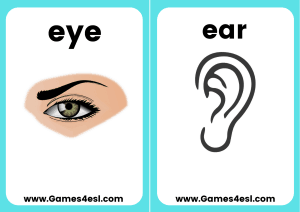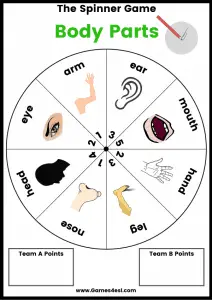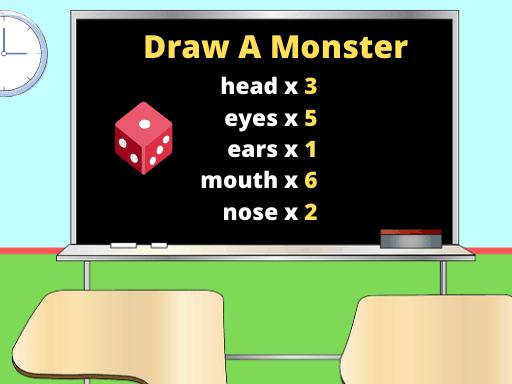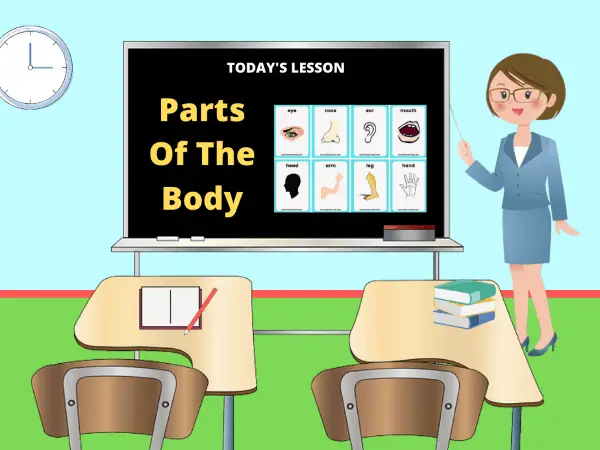Parts Of The Body – A Complete ESL Lesson Plan
Parts of the Body is an essential topic when teaching English to kids / beginner students. Once students have learned body parts vocabulary they can use these words to describe themselves and others, to ask and answer about sickness and health, and to talk about many other things.
On this page you can find a complete ESL Lesson plan to teach body parts vocabulary to kids. Although the activities are mainly aimed at young learners, these activities can be easily adapted for older beginner ESL students.
See the below for all the materials you need for this lesson, including printable flashcards, board games, and links to fun songs. Also check out the bottom of this page for additional resources to teach body parts to ESL students.
Materials for this lesson:
Body Parts Lesson Plan for Beginner ESL Students
Introduction and Warm Up
A great way to start your body parts class is with a fun song. A good ESL song will motivate and energize your students and get them ready for class. A great song to teach body parts and motivate your students is ‘Heads, Shoulders, Knees, and Toes.’ There are hundreds of ‘Heads, Shoulders, Knees, and Toes’ songs on YouTube. Our favorite is this version from Super Simple Songs, but you can use any song you like.
To start the class, play one of the songs and ask students to try and guess what they will study today. Then, try to elicit some body parts vocabulary from students. Once the kids have an understanding of what they will study, teach the lyrics of the song and sing together as a class while doing the ‘Heads, Shoulders, Knees, and Toes’ dance. If you’re not familiar with this dance, it is very easy. As you sing the song, touch the corresponding body part with both of your hands.
TIP: To make this song more fun, once students have practiced a few times, speed up the song on YouTube. Young children will find this really fun as they try to keep up with the fast song.
Practice Key Words And Sentences

Using these body parts flashcards, practice the keywords by showing the flashcards and asking students to repeat after you. Then, ask students to try to say the words on their own. Once students have practiced enough, practice more with this fun ‘Simon Says’ style game:
Activity 1: Touch Your Nose, Please
This game is a ‘Simon Says‘ style game, but using the word “please” instead of “Simon says”. Ask all students to stand up. Then, before playing the game, practice. Tell students to listen to your instructions and do as you say. For example, you might say, “Touch your nose.” and the students should touch their nose with their finger. Practice a few more times until the students can easily follow your instructions. Next, tell students to do as you say only if you say the word ‘please’. For example, “Touch your nose, please.”, “Touch your head, please.”, etc. If you don’t say please and a student still does the action, then that student is out and must sit down.
This game is incredibly fun and a great way to practice listening to body parts vocabulary. To make it more fun and to test your students’ listening ability, replace ‘please’ with words that sound similar (cheese, bees, etc.) and see if you can make them make a mistake.
Activity 2: Board Game – The Spinner Game

This board game is best played in pairs and is designed to get the kids speaking using parts of the body vocabulary. Each pair of students need one pencil and one paper clip for this game.
Students should take turns and place the paper clip in the middle of the circle and place their pencil in the middle of the clip. Then they should flick the paper clip to make it spin. When the clip stops spinning, the student should make a sentence using that word.
For example, if the clip lands on the word ‘head’, then the student can say to his/her partner, “Touch your head.”, and their partner must touch his/her head. Then the student can write his/her points in the box at the bottom. For other printable lesson materials on many topics, click here.
Activity 3: Draw A Monster

For this final activity, each student needs a piece of paper and a pencil, and the teacher needs one die (dice). Write the body parts vocabulary on the board or place the flashcards on the board. Then, for each body part word, roll the dice and write that number next to the word (or invite some students up to the front to roll the dice).
Once you have a number next to each body part, it’s time for the students to draw a monster. Tell students that they must draw a monster with the same number of body parts as is written on the board (i.e., 4 eyes, 6 ears, 2 heads, 1 arm, etc.). Give students 10 minutes or so to complete their monster and then collect their pictures and show them to the class.
Kids absolutely love this game and will be falling off their chairs laughing when they see the funny monsters that their classmates drew.
Review
Before finishing the class, review the keywords from the lesson. A great way to do this is with a simple flashcard game. Using the body parts flashcards, choose one and don’t show the students. Then ask students to try to guess what the word is. When a student guesses correctly, let that student come to the front and choose the next flashcard. This simple game makes students try to recall the keywords from the lesson.
Related Resources
Body Parts Worksheets
Body Parts PPT
Body Parts Flashcards and Board Games
Parts Of The Body Vocabulary Exercises
Body Parts Quiz


